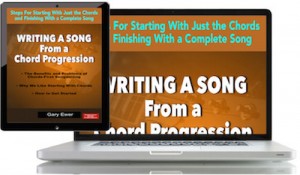Of all the various elements that go together to make a song, a chord progression can get away with being less than imaginative. Your melody and lyric both need to be new and interesting, or else you haven’t written an original song. But the chords might be as mundane as a standard I-IV-V-I type of progression without anyone really noticing.
 If you like the chords-first songwriting process, there are pitfalls that you need to be sure to avoid. “Writing a Song From a Chord Progression” shows you how to make sure that your chords-first song has great melodies and lyrics.
If you like the chords-first songwriting process, there are pitfalls that you need to be sure to avoid. “Writing a Song From a Chord Progression” shows you how to make sure that your chords-first song has great melodies and lyrics.
It’s one of the reasons I often say on this blog that you could be wasting time if you’re trying to come up with a truly unique progression. Most of them have been done anyway.
But there is actually one good reason why spending time developing a somewhat more creative chord progression could be time well spent, and it’s due to the mood that a progression gives. Hand in hand with the performance style of the players, the path that a creative chord progression takes can help to quickly establish and maintain a mood.
A few days ago I was remembering one of David Bowie’s later songs, “Where Are We Now?” from his 2013 album “The Next Day”. I wrote an analysis of the song back when it was released which you can read here: Song Analysis: David Bowie’s “Where Are We Now?”
It’s a gorgeous tune, in large part due to its unique chord progression which, partnered with the performance style, goes a long way to creating a beautiful underlay of melancholy tinged with sadness:
Verse Progression:
Fmaj9 Gadd9 Db/Eb Eb/Db F/C Bø7/C Bbm/C C
As you can see it’s anything but a standard progression. If you think of it in F major, you could think of it as an extremely fancy way to get from F to C. But more than the structural mechanics of the progression, the inversions and the slowly descending baseline, from Eb down to B, help to pull out that very important quality of melancholy.
It’s hard to instruct someone as to how to write this sort of progression, because it probably came largely as a result of improvising. But improvising progressions like this requires:
- a very good knowledge base of chords. If you’re a guitarist, you need to be practicing daily to expand the repertoire of chords you have at your disposal.
- creating progressions that have an overall direction and target. I mentioned that Bowie’s progression could be seen as a fancy way to get from F to C. Bowie might have seen the progression that way: he may simply have wanted to fill the space between an F chord and a C chord with chords that amplified the feeling of melancholy he was looking for. Downward-moving bass lines can do that. But no matter how creative he got with the progression, he never lost sight of F as the tonic.
If you are interested in writing your own creative chord progressions, remember the following three things:
- Never lose sight of the tonic chord. Your progression can get long, and it can wander. But ultimately, in the pop genres, you’ll want to find your way back to that all-important tonic chord.
- Let verses wander (harmonically speaking) more than choruses. A complex verse should usually be followed by a simpler, tonally stronger chorus.
- Don’t let an interesting progression pull focus from good lyrics or good melodies. You still need good words and tunes for a song to make a complete and powerful impact.
 Written by Gary Ewer. Follow Gary on Twitter.
Written by Gary Ewer. Follow Gary on Twitter.
 Each eBook in “The Essential Secrets of Songwriting” 10-eBook Bundles shows you the fundamental principles that make great songs great. Includes several eBooks that deal with chord progressions.
Each eBook in “The Essential Secrets of Songwriting” 10-eBook Bundles shows you the fundamental principles that make great songs great. Includes several eBooks that deal with chord progressions.










